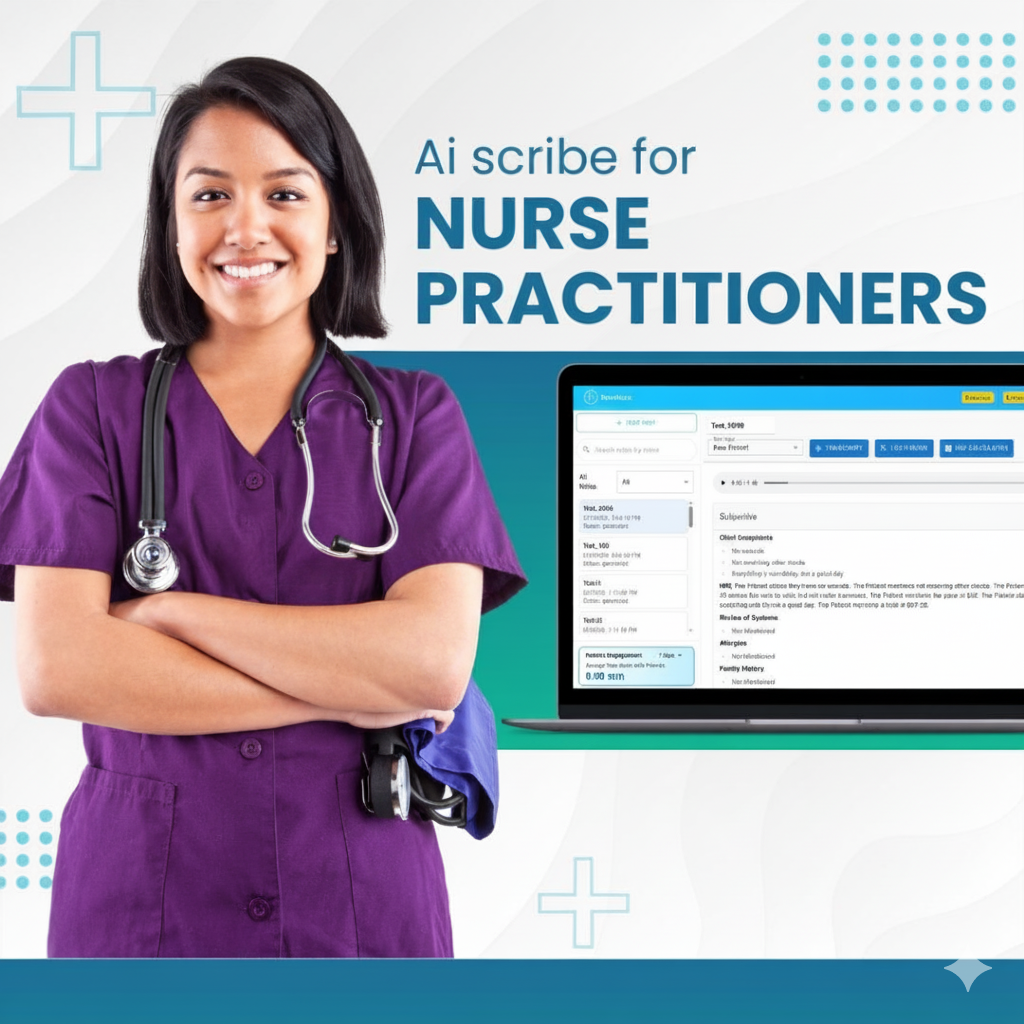AI scribes for nurse practitioners are changing the way healthcare staff works in primary care. Over the years, nurse practitioners (NPs) spend 2-3 hours every day just for clinical documentation and EHR charting. Instead of focusing on patients, they have to deal with a time-consuming paperwork burden. This after-hours charting and administrative workload often leads to stress and less face-to-face time with patients.
With the adaptation of AI medical scribes, things are starting to change. It listens to patient-provider conversation during visit and automatically generates medical notes and uploads them straight to the EHR system. As a result, NPs can now spend more time connecting with patients.
Today, in this blog, we are exploring how AI scribes for nurse practitioners are helping them in primary care.
Understanding the Role of Nurse Practitioners in Primary Care
The healthcare industry is growing fast, and there are not enough doctors to fulfill the demand. This is where nurse practitioners step in. They are highly trained and experienced healthcare providers who diagnose patients’ illnesses, prescribe medicines, and guide patients through treatment plans. They play a big role in preventative care, family medicine, and chronic disease management. They are not only responsible for seeing patients for regular check-ups but also handle long-term care for chronic conditions. This growing responsibility comes with a heavy load of clinical documentation, which leads to stress and burnout.
Documentation Challenges Faced by Nurse Practitioners
Nurse practitioners are skilled at treating patients, but they often spend 25% of their working hours on managing documentation tasks. Every patient visit needs detailed notes, test results, prescriptions, and follow-up details charted into the EHR system.
Studies show that clinicians and nurse practitioners spend almost half of their day on clinical note-taking, EHR charting, and documentation. Many of them have to complete the documentation paperwork even after going home. This long “pajama time” and stress from paperwork can lead to fatigue and lower job satisfaction. Sometimes, more screen time means less face-to-face patient interaction, which can weaken the patient-provider relationship.
To overcome these challenges, AI scribes for nurse practitioners come in.
What is AI Medical Scribe?
AI scribes are digital assistants for clinicians and nurse practitioners who work silently in the background during patient visits. This AI-powered tool uses advanced machine learning and natural language processing (NLP) technology to carefully listen to, capture, and understand patient-NP interactions and create accurate clinical notes in real time. These generated SOAP notes are then directly saved into the existing EHR system.
Compared to traditional human scribes, AI scribes for nurse practitioners are available 24/7 and can handle multiple types of patient visits.
Key Features:
- Real-time voice-to-text transcription
- Automatic structuring of SOAP notes (patient medical history, diagnosis, treatment plans)
- Seamless EHR integration to save clinical notes directly into it
- Specialty-specific customization templates for different types of care
Benefits of AI Scribes for Nurse Practitioners in Primary Care
AI medical scribes bring many advantages for NPs working in busy primary care settings:
More Face-to-face Time with Patients:
With the help of AI scribes, nurse practitioners do not keep typing or looking at the screens during patient visits. As the scribing tool automatically listens and generates notes in real time, NPs can now give their full attention to their patients. When the providers are fully focused on the patients rather than the computer screen, patients feel more valued. Silently handling the documentation tasks in the background, AI medical scribes help NPs to maintain better eye contact and stronger patient-provider connections.
Reduced Administrative Burden:
Most NPs are used to spending hours after their shift managing a burdensome documentation workload. This late-night “pajama time” takes away their personal and family time. AI scribes are here to reduce this burden by automatically generating patients’ notes, prescriptions, care summaries, and more during the visit. This not only saves NP’s valuable time for patient care but also lets them focus on their quality time.
Better Accuracy:
Manual note-taking and documentation can sometimes miss important details, especially when the nurse practitioners are rushed between patients. An AI scribe for nurse practitioners captures the entire conversation in real time and structures it into clear and accurate SOAP notes. This ensures that not a single detail or instruction is missed. More accurate clinical records lead to fewer mistakes and better patient care.
Support for All Practices:
AI medical scribes for nurse practitioners are flexible and can easily fit into different healthcare settings. In the small clinic, an AI scribe provides 24/7 support at a much lower cost. In larger health systems, AI scribes can be scaled across many providers at once, ensuring consistent documentation and reducing workloads across the board.
Improved Work-Life Balance:
One of the biggest benefits of AI scribes for nurse practitioners is the way they give time back to them. By cutting down on hours spent typing notes after visits, providers get more time for rest, family, or personal care. This balance is important for NP's mental health and helps reduce burnout.
The Final Thoughts
AI scribes for nurse practitioners are the real solution to everyday problems in primary care. By reducing administrative paperwork, improving accuracy, and giving NPs more time with patients, AI scribes are reshaping the way healthcare is delivered.
Instead of replacing providers, these tools act as helpful partners, allowing NPs to focus on what truly matters: caring for patients. As healthcare continues to evolve, AI scribes will play a key role in creating a future where primary care is more efficient, more accurate, and more patient-friendly.





Comments